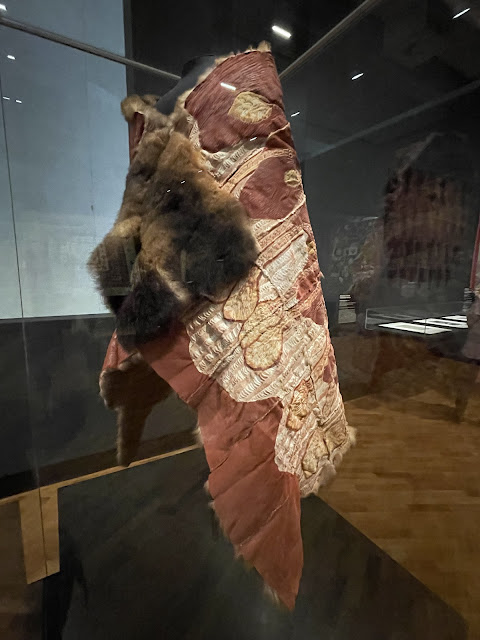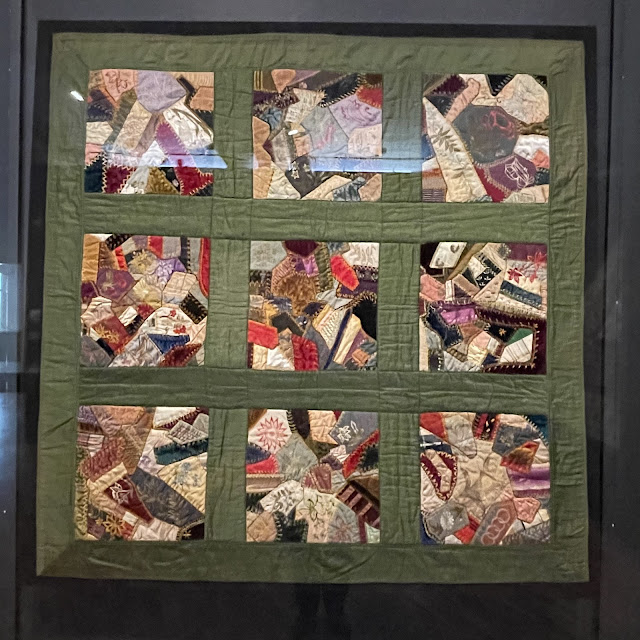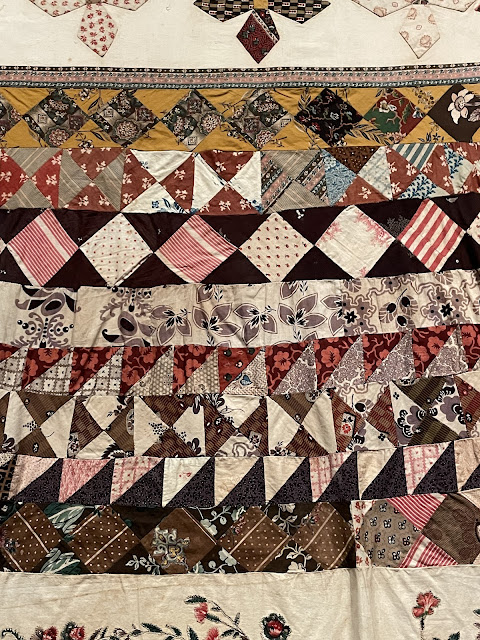The main reason for our timing to visit Canberra was to see the quilt exhibition at the National Gallery, and in particular, the Rajah Quilt. The exhibition wasn’t all that large, but there were some lovely and varied quilts.
We start with a possum skin cloak, such as the aboriginals made. This dates from the 2005, so a contemporary interpretation.
Early European settlers also made use of the warm possum skins. This one from Tasmania has the pelts backed by a woollen fabric. It is somewhat unusual with the tails still attached.
This quilt was made during the 1870s and 1880s, by a lady who was a dressmaker. She entered it in the local show each year for 10 years, winning first prize every time. You have to laugh. It is edged with a braid and backed with a fabric commemorating Queen Victoria’s 1887 Golden Jubilee.
There were two crazy patchwork quilts, quite different in style.
This next quilt was interesting. Quite naive in style, it was made when the lady was in her 80s and she apparently made at least ten for her grandchildren. It is unusual, as it features aboriginals in the design.
The log cabin caught my eye. Made between 1910 and 1928, the logs are only about a quarter of an inch wide. The fabrics were all scraps from a drapery store.
This was an example of a Wagga quilt, made from scraps of woollen fabrics with a cotton backing.
There was a second, more utilitarian, Wagga quilt made from tailoring samples.
From a distance, this quilt is rather bland, but when you look closer, there are some gorgeous 1930s fabrics. The sashings appear to be a rather fine machine embroidered fabric that would be more likely to be seen on an evening gown. The maker had rheumatoid arthritis, and had one of the very early electric sewing machines, which made this type of work possible for her.
The next one was rather unusual, as it was made from agricultural show prize winning ribbons for their cattle. She had even made a bag from more ribbons to store it. It has a lovely subtle colour wash to it.
There was a lovely hexy quilt, which uses fabrics similar to the Rajah quilt, so is dated from 1840 - 1860. Some are fussy cut, while others are random. There seems to be a bit of a layout pattern, but not really consistent. It has a gorgeous backing fabric.
There was a beautiful unfinished diamond quilt. In 1899 the maker died at the age of 30 without completing it.
This beauty is a table cover made from silks, satins and other luxury fabrics. The design and colour placement is stunning.
There was one other beautiful red and white quilt, but there was a large group of women in front of it and I forgot to go back, which is a pity.
And finally, the Rajah Quilt - just to prove that I saw it.
It was much larger than I expected. There is some rather detailed stitchery, suggesting that at least some of the women were proficient needle women. There is quite a bit of broderie perse in the applique. Apparently there was just one free woman on the voyage and at the age of 23, she was sent to coordinate the quilt. What a task that must have been.
The quilt was gifted to the Governor of Tasmania’s wife upon their arrival. Somewhere along the line it was sent back to England. It is unknown if Elizabeth Fry saw it or not. Then it disappeared, only to be discovered in an attic in Scotland in the 1980s. Having been stored away and not used has contributed to the fact it is is such wonderful condition for its age.
Anyway, I’ll let the photos do the talking.
I’m so pleased that we made the trip down to see the quilts, as it is rather rare that the Rajah quilt is brought out, due to its fragility.
If you are interested, there will be a one hour long live stream event by the curator and conservator, held on 29 May at 6.30pm eastern Australia time that will discuss the Rajah Quilt in depth. Here is the link to register.




































10 comments:
Beautiful display of quilts. I was lucky enough to see the Rajah quilt back in 2010 at the V&A Museum UK.
Thanks for the photos.
It was an interesting exhibition, for sure! Lovely to see the Rajah Quilt again, too....I had forgotten how big it was.
Wow, what an interesting post! Who knew possum pelts could be used like that. I love the Log Cabin thin pieces. And the amazing Rajah quilt with the surprising story behind it. How sad they were convict prisoners but at least got to stitch. And that lady supervising...what a story she could tell I bet. Loved seeing you too!
awesome quilt indeed....and the others as well...such a variety of techniques and materials...
Ah....so that was the timing of the trip to ACT. So glad you got to see the lovely old quilts and now have some great memories. Thanks for sharing, take care & hugs.
Lovely to see tha quilts and I enjoyed your notes about them ... I did see the Rajah quilt at a similar exhibition in Brisbane and I am hoping to listen to the livestream...
Hugz
Thanks for all the pics and info Janice- it sounds wonderful to see these quilts in real life.
Thank you for sharing all those amazing quilts. I saw the Rajah quilt several years ago and it is wonderful and loved it's story.
Great history here, Janice. I love the Aboriginal one - so cool as well as the story that there were others.
I also liked the story and the wonderful quilt made by prisoners on a ship. That is very interesting that they were allowed needles and scissors.
Lovely photos of the quilts Janice, we considered doing the exhibition when we were in the area in April, but cut our holiday short by a week, so were on a mission to get home.
Post a Comment